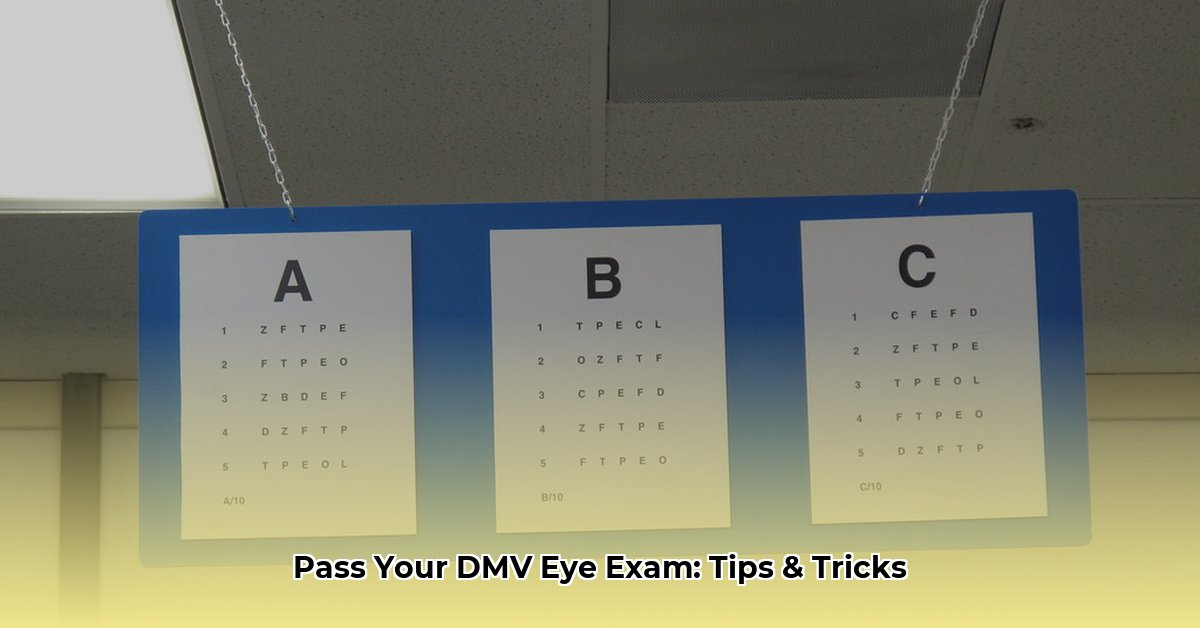Understanding Vision and the DMV Test
Getting ready for your DMV eye exam? It’s natural to feel a little anxious, but with a little preparation, you can approach the test with confidence. This guide will walk you through everything you need to know, from deciphering “20/20 vision” to understanding the Snellen chart and state-specific requirements.
What Does 20/20 Vision Mean?
“20/20 vision” is a measurement of visual acuity, or how clearly you see at a distance. The first number (20) represents the standard testing distance of 20 feet. The second number represents the distance at which a person with normal vision could read the same line you’re reading. So, 20/20 vision means you see at 20 feet what a person with normal vision sees at 20 feet. 20/40 vision suggests you need to be 20 feet away to see what someone with normal vision can see from 40 feet.
Decoding the Snellen Chart
The Snellen chart, that familiar poster with rows of shrinking letters, is the standard tool for measuring visual acuity. The chart helps determine your 20/X vision score. Practicing with a printable Snellen chart can familiarize you with the format and potentially highlight any vision concerns.
Preparing with a Printable Snellen Chart
Want a sneak peek at what to expect? A printable Snellen chart can help you prepare for the real test. Here’s how to use one effectively:
- Print and Prepare: Download a high-quality printable Snellen chart and print it on standard-sized paper. Ensure the letters are clear and easy to read.
- Set Up Your Testing Area: Tape the chart to a well-lit wall at eye level. Measure and mark a spot exactly 20 feet away—this is crucial for accurate results.
- Test Each Eye Individually: Cover one eye without pressing on it. Read the smallest line of letters you can comfortably see without straining.
- Repeat and Record: Switch eyes and repeat the process. Write down the fraction (e.g., 20/40) next to the smallest line read for each eye. This is your visual acuity measurement for that eye.
State-Specific Vision Requirements: Know Your Local Rules
Vision requirements for driving vary by state. Some states require 20/40 vision, while others may have different standards or allow variations with corrective lenses. Always check your state’s DMV website for the most current and accurate information. Below is a partial table – always confirm with your state’s DMV:
| State | Visual Acuity (with/without correction) | Visual Field (degrees) | Other Tests | Corrective Lenses Allowed? | Restrictions | Renewal Requirements |
|---|---|---|---|---|---|---|
| Alabama (AL) | 20/40 (either eye)¹ | Not specified¹ | Color vision may be tested ¹ | Yes¹ | May be restricted if vision is worse than 20/70 ¹ | Vision test required at every other renewal¹ |
| Alaska (AK) | 20/40 (best eye corrected), 20/70 (other eye)¹ | 110 degrees total¹ | Color vision may be tested ¹ | Yes ¹ | May require corrective lenses¹ | Vision test required at every other renewal¹ |
| … | … | … | … | … | … | … |
¹ These requirements are examples and may not be fully up-to-date. Always check your local DMV website for the latest information.
Beyond Visual Acuity: Other Aspects of the DMV Eye Exam
While visual acuity is key, the DMV exam might also assess other aspects of your vision:
- Peripheral Vision: This measures your ability to see objects outside your direct line of sight. It’s crucial for detecting pedestrians, cyclists, and other vehicles.
- Color Vision: This test, often using Ishihara plates, ensures you can distinguish traffic signals.
What If I Don’t Pass?
Not meeting the vision requirements doesn’t automatically disqualify you from driving. You’ll likely be referred to an eye care professional for a comprehensive exam. A new prescription for glasses or contacts might be all you need. Some states may impose driving restrictions, such as requiring corrective lenses or limiting nighttime driving.
Tips for Healthy Vision
Maintaining good vision is a lifelong commitment. Regular eye checkups, a healthy diet, proper lighting, and potentially eye exercises (consult your eye doctor) can contribute to optimal eye health.
Disclaimer
This guide provides general information and should not be substituted for professional medical advice. Consult a qualified eye care professional for any vision concerns. Always refer to your state’s DMV for the most current regulations.
- How to Stop Apps From Running in the Background to Boost Your - December 1, 2025
- How To Move Apps On Your Droid For Better Organization - November 30, 2025
- How to Move Apps on Android for Better Organization - November 29, 2025










